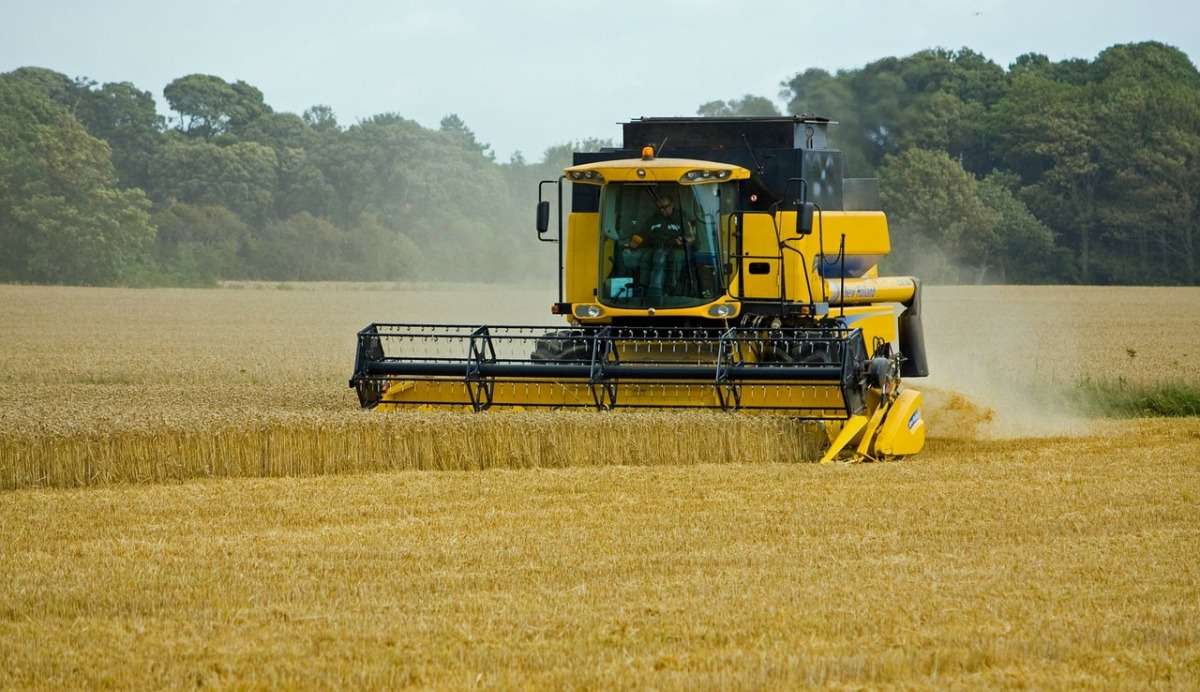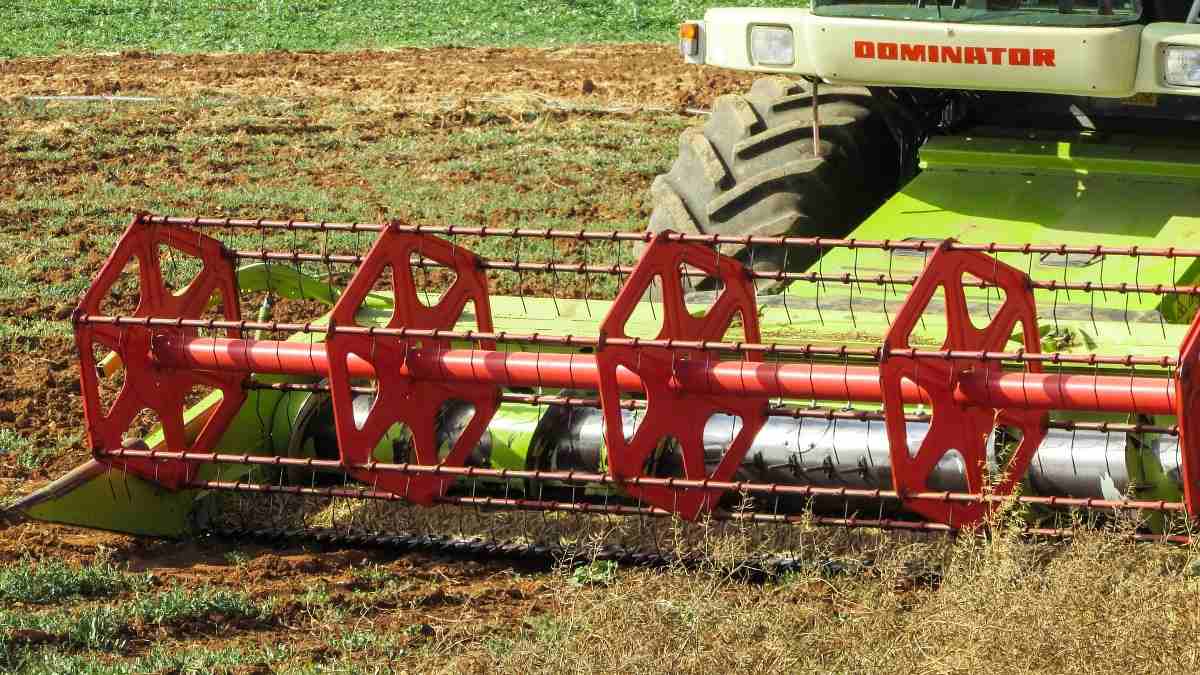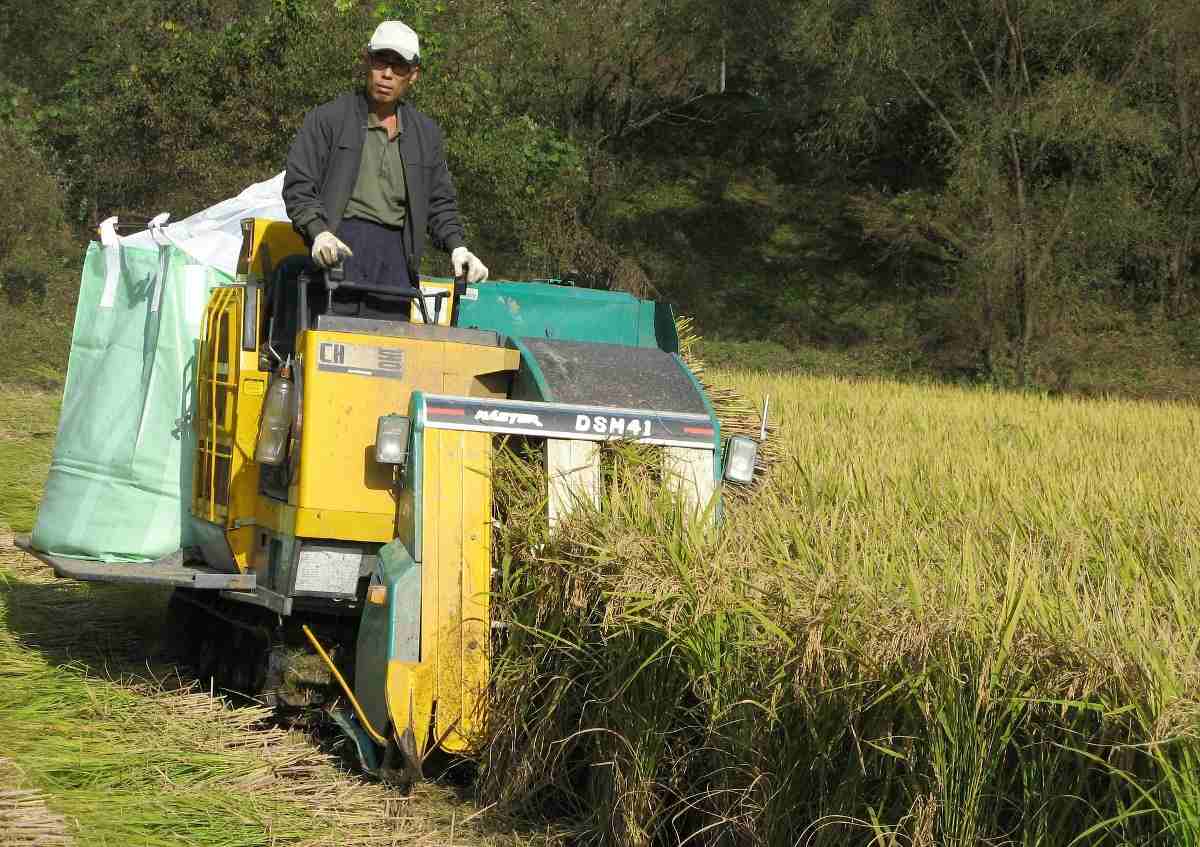Farm Mechanization in India
Introduction to farm mechanization in India, challenges, advantages, and scope in India: Farm Mechanization indicates the use of machines for agricultural operations replacing the traditional ways which involve human and animal labor. Effective Farm Mechanization contributes to increasing production in two major ways. They are firstly the timeliness of operation and secondly the good quality of work. The power requirement for certain operations such as seedbed preparation, cultivation, and harvesting become so great that the existing human and animal power in the country appears to be inadequate. As a result, the operations are partially done or sometimes completely neglected, resulting in low yield due to poor growth or untimely harvesting, or both. And it is mainly applicable to land preparation, planting, fertilizer application; crop harvesting, care and feeding of animals as well as processing and storage of Farm produce using appropriate Farm Machines.
A guide to farm mechanization in India, benefits, problems, scope
In a mechanized farm, the plowing process is done by tractor; sowing and applying fertilizer by the drill, and reaping the threshing by the combined harvest thresher, etc. Therefore, the mechanization of agriculture involves the use of different types of machinery in farming operations right from plowing to the marketing of produce. Mechanization can be either complete or partial.
All the farming operations are done by machines reducing human labor and displacing animal labor completely then the mechanization is complete. But when machines are used along with traditional ways in agricultural operation then the mechanization is partial. In developed countries as the supply of labor is scarce so they go for complete mechanization of agriculture.
The factors which are creating hurdles against the mechanization of agriculture in India contain mounting pressure of population on land, fragmented holding, and ignorance among the farmers, etc. Also improvements in the quality and value addition of the agricultural produce and enabling the farmers to raise a second crop or multi-crops making the Indian agriculture more attractive.
You should not miss the Medicinal Plants Cultivation, Farming Guide, Training.

India is one of the top countries in respect of agricultural production but in terms of Farm Mechanization, it is behind the world average. Tractor density in India is approximately 16 tractors for 1000 hectares of land, while the world average is 19 tractors and that of developed countries is very high. Therefore, it is observed that there are significant opportunities and scope for the mechanization of agriculture.
Farm mechanization in allied sectors of India
In the dairy and livestock sector, which is largely integrated with an associated industry and the adoption of mechanization has been more common. Milking machines, fodder handling, and feeding machines, and harvesting systems in abattoirs, etc. are examples. In the fisheries sector, the adoption of mechanization has been more, and it has reaped more benefits. Examples are, range from mechanized fishing boats which deploy propulsion and motorized net handling equipment, and fish pond management equipment, etc. Factory ships in the fisheries sub-sector are the largest format of machines and mechanization deployed in the agricultural sector. On-farm fields, mechanized tilling, and harvesting are most commonly used and India is the largest market for tractors and a variety of harvester machines. Irrigation pumps, fertigation systems, and pesticide applicators are other mechanized forms of farm inputs. Though, given the scale of India’s agricultural sub-sectors, mechanization is yet to penetrate all across regions and farm types. One of the major limitations to deploying farming machines is the capacity of a farm to efficiently own such equipment. Small farmers will continue to be the mainstay of Indian agriculture and the concept of custom hiring centers and mechanized services is most apt in this situation.
Scope of farm mechanization in India
There is a good scope of Farm Mechanization in India due to the below factors;
- Improved irrigation facility in the country.
- Introduction of high-yielding varieties of seeds.
- Introduction of a high dose of fertilizers and pesticides for many crops.
- Introduction of new and high-yielding crops in different parts of the country.
- Multiple cropping systems and intensive cultivation in different parts of the country.
State of farm mechanization
The agricultural system all over the world has changed in terms of cropping; the type of power sources used and input application to achieve a high level of productivities. Even in India, the Farm Mechanization of agriculture has advanced considerably. In a certain region, the level of Farm Mechanization has gone far ahead of the average level in the country. Power sources are no longer the predominant sources on Indian farms and the annual addition of tractors is more than one hundred thousand tractors. Similarly, the hundred thousand pump sets are installed on Indian farms annually. Based on an annually critical review of the Farm Mechanization position, one observes that the shortage of labor and high labor wages is the factors that strongly propel mechanization. Thus, the more labor-intensive operations, which are pumping of irrigation, land preparation, and threshing are the first operations, which are mechanized. Large amounts of labor or draft power, which can be replaced through farm machines, provides a strong incentive to mechanize. The farm operations, which can be mainly categorized as;
- Highly power-intensive operations,
- Intermediate power and control intensive operations,
- Highly control intensive operations.
Challenges in front of farm mechanization in India
In case if you miss this: Custard Apple Cultivation Income, Yield, Project Report.

Challenges through the perspective of various stakeholders;
Marginal farmers
Integrating marginal farmers into the Farm Mechanization gambit is important. Major constraints are;
- Marginal farmers believe higher technology is complex.
- The second deterrent is the higher cost of equipment and the need for high investment into a variety of equipment, size, and technology for different conditions, and crops.
Delivery mechanism
The delivery mechanism requires adequate resource building with easy and affordable access to the farmers. Implement bank, pay per use could be possible solutions but need diligent planning and execution. Another challenge is knowledge transfer for usage and manufacturing. Importing new technology is expensive and hence needs to adapt to Indian conditions. At the same time, a large investment is necessary for skill building for correct usage.
Institutions
The country needs to invest in design and development. Not only for adaption but also we need versatile equipment that can be used in multiple crops like we have multi-crop harvesters and tractors. Another major shift required is blended with agronomic practices and Farm Mechanization.
Rural infrastructure
Field accessibility for machinery movement into the field is poor. Our fields are smaller and not connected with roads and many a time moving machine from one field location to others is not possible and efficient.
Prospects of farm mechanization in India
Farm Mechanization is a growing trend of rural populations migrating to urban areas to earn their living, leading to a huge shortfall in labor required for farm activities. Due to this reason, farmers are now turning to Farm Mechanization to fill up this gap.
The Department realized the need to enhance Farm Mechanization domestically has through the Mechanical Wing undertaken steps to promote the usage of farm machinery by domestic farmers. This is being taken up under the central program known as Sub-Mission on Agricultural Mechanization (SMAM). Under this central program, farmers are being encouraged to purchase Agricultural Machineries at subsidized rates. Demonstrations of new and improved machinery are being conducted by the Department at the Farmers Field to create awareness as well as to encourage usage of such machinery.
Considering the shortfall of farm labor, coupled with the increasing inclination of farmers towards mechanization as a result of State or Central Government’s assistance, we can say that the prospects of Farm Mechanization in the State are encouraging.
Benefits of farm/agriculture mechanization
Mechanization of the farm has provided below benefits to the agricultural sector;
The mechanization of farms has led to an increase in the agricultural production volume. In developed countries, Farm Mechanization has increased agricultural production and productivity. A survey conducted in India reveals that productivity per hectare is higher in a mechanized farm than that of non-mechanized farms.
Farm Mechanization increases labor productivity as the same output can be raised by the lesser number of laborers. The application of farm machines has relieved the agricultural laborers much of the heavy work such as land reclamation, plowing, digging, and carrying of soil.
You may also like the Hydroponic Tomato Farming, Nutrient Solution, Yield.

The mechanization of agriculture helps to derive an increased volume of economic surplus which not induces the farmers to develop their agricultural farm but also helps towards industrial development and infrastructural development in a country.
Large-scale farming has become possible due to agriculture mechanization which has reduced the cost of production. Farm Mechanization can solve the labor bottlenecks faced by the farm during the peak period.
Mechanization made intensive cultivation successful and helped the farmers to follow multiple cropping properly.
Input savings – Farm Mechanization is to provide several input savings. They are;
- Seeds (approximately 15-20 percent)
- Fertilizers (approximately 15-20 percent)
- Increased cropping intensity (approximately 5-20 percent).
Increase in efficiency – Farm machinery also helps in increasing the efficiency of farm labor and reducing drudgery and workloads. It is estimated that Farm Mechanization can help reduce time by approximately 15 to 20 percent. Also, it helps in improving the harvest and reducing the post-harvest losses, and improving the quality of cultivation. These advantages and the savings in inputs help in the reduction of production costs and allow farmers to earn more income.
Social benefits of farm mechanization
There are various social benefits of Farm Mechanization are;
- It helps in the conversion of uncultivable land to agricultural land through advanced tilling and in shifting land used for feed and fodder cultivation.
- Decrease in workload on women as a direct consequence of the improved efficiency of labor and improvement in the safety of farm practices.
- It helps in encouraging the youth to join farming and also attracts more people to work and live in rural areas.
Sub Mission on Agricultural Mechanization (SMAM)
The SMAM is providing a suitable platform for converging all activities related to mechanization by providing a ‘single window’ approach for implementation with accelerated and inclusive growth of agricultural mechanization in India.
The objectives of SMAM are;
- Increase the reach of agriculture mechanization to small and the regions of farm power are low;
- Creating hubs for hi-tech and high-value farm equipment’s and promoting custom hiring centers to offset the adverse economies of scale arising due to small landholding;
- Creating awareness among stakeholders through demonstration and building activities; and,
- Ensuring performance testing and certification at designated testing centers placed all over the country.
Limitation of farm mechanization
Limitations of Farm Mechanization are;
- Economic Limitation
- Machines are readily available in the country.
- The cost of hiring machines is too high.
- The cost of maintenance is high.
- The operation of machines demands and high nay or wages which farmers cannot afford.
- Technical Limitation
- There is a lack of technical know-how of machines and experts on these machines are not readily available.
- The mode of operations of most machines is unknown.
- Most of the machines are not adapted to our environment or needs.
- Lack of Maintenance
- Most machines are imported and can be hard to maintain due to spare parts that might also not be obtainable in the country and many more.
- Replacement of spare parts is not available.
- Inadequately trained personnel to repair Farm Machines.
- Facilities for repair Maintenance are lacking.
- The few trained personnel are not always available when Machines break down.
- Small Farms Holding
- Fragmentation of land discourages Mechanization.
- Agriculture is practiced by peasant farmers.
Scope for improvement of farm mechanization
The main impediments for Farm Mechanization in the State are given below;
- Small and fragmented land holdings
- The high cost of farm equipment ownership
- Lack of credible financing for domestic farmers
- Overall landholding in the state is fragmented.
A large proportion of land is held by small and marginal farmers who by their economic condition are unable to purchase farm machinery on their own. This can be addressed if the State/Central Government increases their share of assistance to the farmers. Steps must be taken to ensure that the financial institutions simplify their procedure for assisting farmers in need of a loan for the purchase of agricultural machinery.
Disadvantages of agricultural mechanization
Farm Mechanization has the below disadvantages;
High cost – Farm Mechanization, due to the numerous machines involved generally expensive to operate.
Displacement of workers – In Farm Mechanization, few workers are required; hence, many people will be out of a job when mechanization is introduced.
Compaction of soil – Farm Mechanization leads to compaction of soil due to the movement of heavy machines.
Degradation of the landscape – Farm Mechanization ensures the degradation of the landscape as a result of continuous excavation.
Land tenure system – Land tenure system can hinder the efficient use of tractors due to small holdings of farmlands.
In case if you are interested in this: How To Grow Organic Lettuce.
- Economical Aquaculture: A Guide to Low-Budget Fish Farming
- 15 Common Planting Errors That Can Doom Your Fruit Trees
- How to Make Houseplants Bushy: Effective Tips and Ideas
- Innovative Strategies for Boosting Coconut Pollination and Yield
- Pollination Strategies for Maximum Pumpkin Yield
- The Complete Guide to Chicken Fattening: Strategies for Maximum Growth
- Natural Solutions for Tulip Problems: 100% Effective Remedies for Leaf and Bulb-Related Issues
- Revolutionizing Citrus Preservation: Towards a Healthier, Greener Future
- Natural Solutions for Peony Leaf and Flower Problems: 100% Effective Remedies
- Maximizing Profits with Avocado Contract Farming in India: A Comprehensive Guide
- Natural Solutions for Hydrangea Problems: 100% Effective Remedies for Leaf and Flowers
- The Ultimate Guide to Choosing the Perfect Foliage Friend: Bringing Life Indoors
- From Sunlight to Sustainability: 15 Ways to Use Solar Technology in Agriculture
- The Ultimate Guide to Dong Tao Chicken: Exploring from History to Raising
- The Eco-Friendly Makeover: How to Convert Your Unused Swimming Pool into a Fish Pond
- Mastering the Art of Delaware Chicken Farming: Essentials for Healthy Backyard Flocks
- 20 Best Homemade Fertilizers for Money Plant: DIY Recipes and Application Methods
- How to Craft a Comprehensive Free-Range Chicken Farming Business Plan